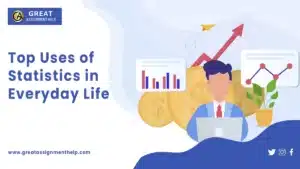Statistics are required in every aspect of life. It offers students a great career and helps them take the right steps to secure a bright future. However, most students are novices to the aspects of daily life where statistics are employed rigorously. Nonetheless, having a clear idea is important to make informed decisions and avoid being cheated. If you want to know about the uses of statistics in day-to-day life, read this blog. Here we have listed out the 16 areas of its utilization.
What Are Statistics?
Statistics is a branch of mathematics that revolves around gathering, examining, arranging, interpreting, and presenting data. It also deals with a huge amount of data to get pertinent information. Data utilized in statistics can be quantitative or qualitative. For example, a precise amount, quantity, or range illustrates quantitative data. Similarly, arithmetic operations signify quantitative data.
In contrast, qualitative data describes estimates and classifications. These data are non-numeric. Hence, statisticians must observe these data to record them.
6 Types of Statistics That You Must Know

There are different types of statistics. However, the following six types are the most popular:
1. Descriptive Statistics
Descriptive statistics employ the data and create graphs, tables, or numerical calculations to explain the population.
2. Inferential Statistics
Inferential statistics make forecasts and draw conclusions rooted in a sample of data from the whole population.
3. Applied statistics
Applied statistics refers to the statistical methods and practices used to resolve specific issues in practical situations. Methods employed in comparable sample surveys, quality control, index numbers, etc. are common examples of applied statistics.
4. Inductive statistics
This section deals with the methods and techniques utilized to assess a specific thing based on random observations. Extrapolation is one of the techniques used in inductive statistics.
5. Analytical Statistics
Analytical statistics employs practices and methods that help to ascertain how variables function together. It studies correlation, regression, association, and attributes.
6. Mathematical statistics
Mathematical statistics highlight how different mathematical concepts and methods can be used to develop new statistical techniques. Integration, differentiation, trigonometry, matrix, etc. are all common examples of mathematical statistics.
Also read: Best Statistics Project Ideas for Students
What Are The Most Common Uses Of Statistics?
Uses of statistics are observed in numerous fields. The most common of them are:
1. Research
One of the most popular uses of statistics is observed in the field of research. In research, statistics draw inferences from a given dataset. Apart from academic research, every industry conducts statistical research to predict outcomes.
2. Economics
Another area where the use of statistics is prominently observed is in the field of economics. Statistics helps in the collection, processing, distribution, and examination of economic data. Economists use the statistical evidence they collect from different sources to criticize government policies. Statistics also aid in implementing economic processes with ease.
3. Machine Learning
Machine learning is one of the most visible developments in technology at present, and it is expected to bring revolutions in the future. The foundation of machine learning lies in statistics. The technology is based on statistical concepts like regression, correlation, modeling, etc. Moreover, statistical hypothesis tests and estimation statistics also play a huge role in machine learning. The statistical algorithms offer insights into the data to develop the most powerful applications.
4. Nursing
Nurses also depend on the use of statistics to identify patterns in visual signs and symptoms. They employ statistics to take better action based on the patient’s conditions and medical figures. Apart from that, they also utilize a variety of statistical software, like MS Excel, to preserve the frequency charts. These charts help them document the timing of medication administration to the patients and record other patient details. On the whole, statistics help nurses offer the best care to their patients to the best of their capability and preserve their daily, weekly, or monthly records.
5. Psychology
It is very difficult for most students to agree that statistics are also helpful in psychology. Psychologists use it to present easily comprehendible data. Mainly, statistics help the psychologist picture the data with the assistance of graphs, pie charts, scatterplots, etc. Moreover, some statistical operations, like frequency distributions, also help psychologists acquire improved data patterns. Thus, statistics play a significant role in helping patients restore their mental health.
6. Cryptocurrency
Cryptocurrency is the most common decentralized currency. It is a digital coin and also depends on statistics. The primary ideas used in cryptocurrency for technical indication are the standard deviation and average deviation. It also uses other statistical concepts for glitch-free operations.
Moreover, Cryptocurrency trading is also founded on statistics. Many traders around the globe invest in cryptocurrency. Statistics help them forecast the cryptocurrency’s price. Apart from that, cryptocurrency companies also carry out various statistical functions to run their coins smoothly. The polarization of cryptocurrencies manages the momentous use of statistics in daily life.
Also read: Understand The Prominent Differences Between Statistics Vs. Parameters
7. Education
Statistics are crucial to the education system. It is utilized to analyze the development of a class in comparison to students in other academic programs. With the assistance of statistics, teachers can examine each student’s performance individually. A detailed examination is always critical for recognizing what a specific student lacks in education and which actions must be taken to enhance it.
Teachers can use statistical methods to establish educational methods to assist an individual student. The psychological ability, intellectual capability, and well-being of each student vary. Based on these traits of a learner, the teacher should offer distinct guidance to the students.
8. Weather Forecasting
Weather forecasting is an excellent use of statistics. Quantitative data is collected for the current condition of the atmosphere, and meteorology is employed to forecast atmospheric transformation. Meteorologists make use of meticulous scientific methods to get significant information from data. Furthermore, they utilize the statistics of atmospheric pressure, temperature, dampness, rain, and speed to forecast future weather situations.
9. Insurance
Uses of statistics are also prominently observed in vehicles, houses, and life and health insurance companies. The experts utilize various statistical data to determine the amount of insurance individuals need. After that, they examine the process and analyze the insurance score. It helps them find out the risks that they must bear to offer the insurance.
10. Pandemic Prediction
Statistics play a significant role in the medical field. The medical field employs statistics to forecast the spread of disease. They often use it to calculate the number of people affected by a specific illness in a specific region. Statistics are also employed to assess the proportion of people affected by that particular disease.
Statistics are also useful in determining the reason for illness, the spread of illness, and taking preventive measures. For example, a statistical survey report highlights that it is established that 80% of the patients who died of COVID-19 had high blood pressure and diabetes.
11. Prediction
The other significant area where the use of statistics is greatly observed is in making predictions from the collected information. The accuracy of predictions depends on many factors. For example, intellectuals consider past and present information whenever they make any prediction. Every rational person examines the aspects that can impact their future. Statistics methods help carry out future projections.
For example, the meteorological department of a country makes forecast predictions about upcoming weather conditions. Moreover, the engineer assumes the cost of completing a project based on a preliminary assessment.
12. Politics
Statistics play an important role in politics. The use of statistics in politics is expanding rapidly. At present, most political campaigns rely on statistics for superior organization. It is crucial to examine the chances of winning before elections.
With the help of statistics, politicians can recognize their odds of winning and the number of voters who support them. Likewise, several news channels use statistical tools like surveys to predict the results of voting.
13. Emergency Situations
Statistics are beneficial for predicting natural disasters such as earthquakes, floods, heat waves, volcanic eruptions, etc. Also, it helps the Government and the citizens get ready for any emergency. In addition to that, statistical tools play a significant role in foreseeing imminent natural disasters. It enables everyone to get ready accordingly. Rescue teams also gear up in advance to lower the number of casualties.
14. Sports
Statistics are used in multiple ways in sports. A sportsman gets a notion about his performance and the functioning of other players. By using statistics, a team can anticipate the functioning of other teams. Based on that expectation, they can map out their practice sessions. There are two types of sports statistics.
- On-field analytics: An on-field analysis is concerned with enhancing the performance of team players on the ground. A team can preserve game plans and players’ fitness with on-field statistics.
- Off-field analytics: It helps sports organizations perk up their businesses. It helps them settle on the ticket price, fan engagement, etc.
15. Government
The government uses statistics in numerous ways. They make decisions about education, policies, population, etc. Some popular uses of statistics in Government are as follows:
- The Government offers medical supplies to the people of a specific area by investigating the count of patients with a specific disease.
- The Government employs statistics to make a decision on the curriculum for students. Statistics tools help in the calculation of the cost of every government project.
- Various campaigns organized to make people aware are also rooted in statistical analysis.
16. Business
There are many uses for statistics in business. A successful business relies on reliable statistics for the industry. Each successful organization employs statistics to expand in the market. They also take the aid of many statistical tools for various statistical functions, for example, median, mode, mean, bar graphs, bell curves, and probability. Statistics in business are very useful for evaluating fashionable goods and the price trends of those products.
Business organizations also compute the accessibility of goods in stock with the help of statistics. Companies can collect information about the store that requires the product and the demand. These statistics help fulfill the product demands of the stores. With the help of statistics, companies also explore predictable sales trends that assist them in planning their future actions. Data available through statistics is always important to businesses for market analysis.
Additional Uses of Statistics in Business
When compared to other sectors, business predominantly relies on statistics for several purposes. Here, let us look at a few more uses of statistics in business.
- Market research: Statistics aid in the analysis of consumer preferences and market trends for well-informed product development and marketing strategies
- Quality control: Statistics identify product variations or defects, allowing them to maintain quality standards.
- Pricing analysis: Statistics analyze customer reactions to price changes, assisting in the development of optimal pricing strategies.
- Inventory management: Statistics forecast product demand, optimizing inventory levels, and eliminating costs.
- Risk Assessment: By examining past data and estimating possible dangers, statistics evaluate and control risks.
- Sales forecasting: Statistics use historical data to predict future sales, helping businesses set goals and schedule production.
- Customer Segmentation: Statistics improve marketing tactics by segmenting customers based on behavioral and demographic data.
- Decision Making: Statistics offer proof for assessing options and coming to data-driven conclusions.
- Financial Analysis: To evaluate performance and assist with financial planning, statistics examine financial data.
- Performance Measurement: Statistics track and assess key performance metrics, such as staff productivity and sales growth, to support strategic planning and development.
Conclusion
By now, you might be aware of the uses of statistics in our daily life. In addition to the uses listed above, statistics also plays a key role in advanced fields such as robotics, aerospace, data science, machine learning, deep learning, and quantum computing. Especially, to examine a large set of collected data and draw relevant conclusions, you may very well use statistics. In case, it is challenging for you to use statistics, get in touch with us. Our team contains knowledgeable and experienced statistics assignment helpers to assist you in meeting your objectives.


